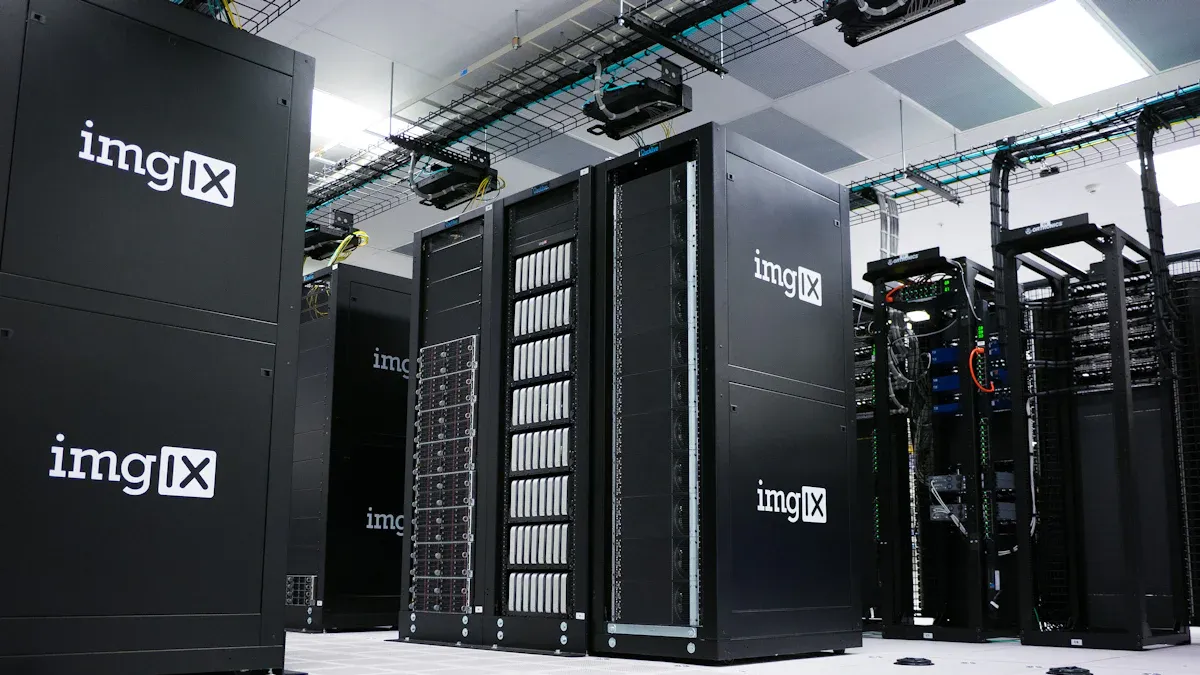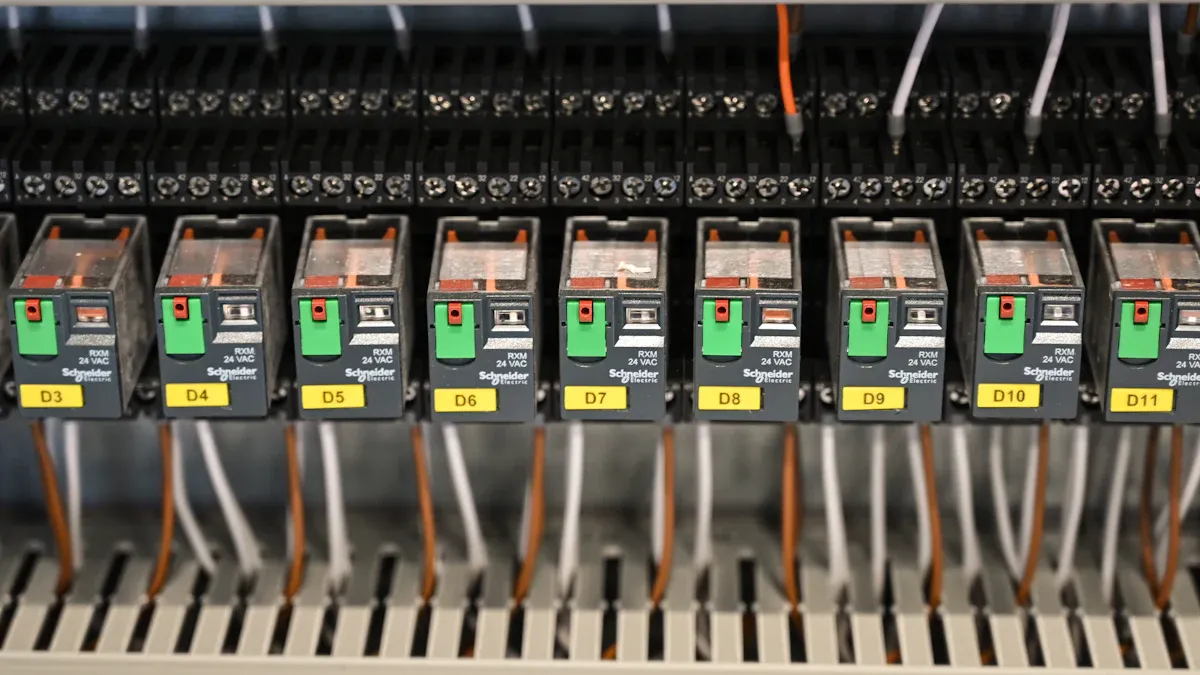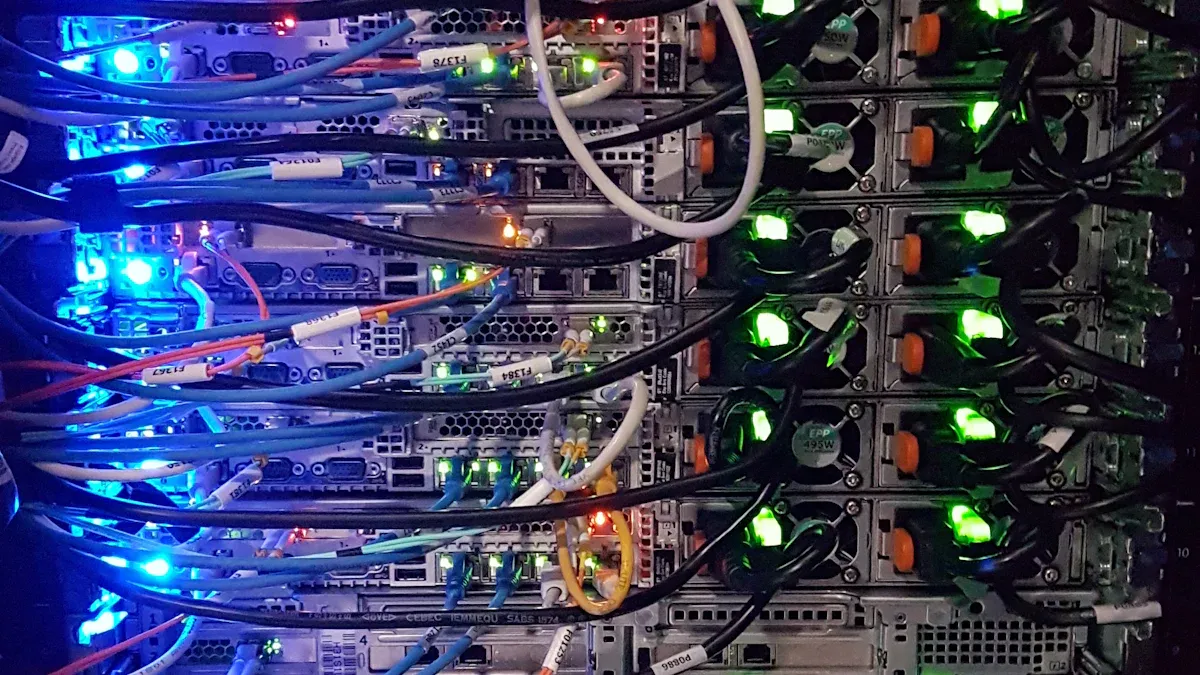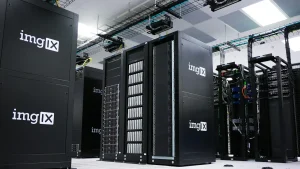
Different Power Distribution Units (PDUs) enhance rack performance, efficiency, and reliability by providing tailored power delivery and management solutions. PDUs are crucial for optimizing rack infrastructure, ensuring stable power, enabling precise monitoring, and facilitating remote control. Power-related issues cause approximately 44% of data center outages, making robust power management essential. Such downtime is costly; it can reach nearly $9,000 per minute for some organizations. Understanding the diverse functionalities of various PDU types, including a specialized 19″ cabinet PDU, is key to maximizing your rack’s operational efficiency and uptime.
Key Takeaways
- Basic PDUs give power to many devices in a rack. They are simple and save money.
- Monitored PDUs show how much power is used. This helps stop power problems before they happen.
- Metered PDUs measure power for each device. This helps save energy and find devices that use too much power.
- Switched PDUs let you turn devices on or off from far away. This makes fixing problems faster and easier.
- Managed PDUs combine all features. They watch power, control devices, and check the rack’s temperature.
- ATS PDUs keep power on without stopping. They switch to a backup power source if the main one fails.
- High-density PDUs fit many power outlets in small spaces. They are good for racks with many servers.
Basic PDU Solutions for Foundational Rack Optimization

Basic Power Distribution Units (PDUs) form the bedrock of any well-organized server rack. They offer essential power distribution without advanced features, focusing on reliability and simplicity. Organizations often choose these units for their straightforward functionality and cost-effectiveness, especially in environments where complex monitoring or remote control is not a primary requirement.
Essential Power Distribution for Rack Equipment
Basic PDUs provide the fundamental service of distributing power to multiple devices within a rack. They ensure every piece of equipment receives the necessary electrical current to operate effectively.
Reliable Power Delivery to Multiple Devices
These units reliably deliver power from a single input source to numerous outlets. They handle the power demands of servers, switches, and other rack-mounted hardware. This centralized distribution prevents the need for multiple wall outlets or power strips, which can lead to disorganized cabling and potential power issues. A basic PDU ensures a stable and consistent power flow to all connected components, supporting continuous operation.
Space-Efficient Power Strip Functionality
Basic PDUs offer a space-efficient design. They typically mount vertically or horizontally within the rack, occupying minimal space. This design maximizes the available rack units for IT equipment. They function much like a robust power strip, but they are specifically engineered for the demanding environment of a data center or server room. Their compact form factor helps maintain a clean and organized rack infrastructure.
Cost-Effective PDU Deployment
Deploying basic PDUs represents a cost-effective solution for managing power within a rack. They offer significant benefits without the higher investment associated with more feature-rich PDU types.
Streamlined Power Connectivity
Basic PDUs streamline power connectivity. They provide a central point for all power connections, reducing cable clutter and simplifying power management. Technicians can easily connect new equipment or disconnect old devices. This organized approach minimizes installation time and reduces the potential for human error during setup or maintenance.
Simplified Rack Setup
These units contribute to a simplified rack setup process. Their plug-and-play nature means they require minimal configuration. Installers mount the PDU, connect it to a power source, and then plug in the rack equipment. This ease of installation makes them ideal for rapid deployments or for smaller IT environments. They provide a reliable and uncomplicated method for powering essential rack components, ensuring a quick and efficient operational start.
Monitored PDU Capabilities for Enhanced Rack Visibility

Monitored Power Distribution Units (PDUs) elevate rack management beyond basic power delivery. They provide critical insights into power consumption, offering data center managers enhanced visibility into their infrastructure. This capability allows for more informed decision-making and proactive management of rack environments.
Real-Time Power Monitoring with a Monitored PDU
A monitored PDU offers real-time power monitoring, which is essential for maintaining optimal operational conditions. This immediate feedback helps predict and prevent power quality problems, significantly reducing the risk of equipment malfunction and costly downtime.
Aggregate Current Tracking
Monitored PDUs continuously track the aggregate current draw across all connected devices. This feature provides a clear picture of the total power load within the rack. Managers can quickly identify when current levels approach critical thresholds, allowing them to take preventative action before an overload occurs.
Voltage and Power Factor Insights
These units also provide valuable insights into voltage and power factor. Monitoring voltage ensures equipment receives stable power, preventing performance issues or damage. Power factor insights help identify inefficiencies in power usage, guiding efforts to optimize energy consumption and improve overall electrical system health. Real-time information from built-in meters helps maintain optimal environmental conditions for equipment and minimizes damage risk.
Proactive Rack Optimization with Data
The data collected by monitored PDUs enables proactive rack optimization. This approach helps data center operators make strategic decisions, ensuring continuous operation and efficient resource allocation.
Preventing Overloads and Downtime
Real-time power monitoring is crucial for preventing overloads and downtime. It keeps data center managers informed about the status of critical power components, enabling quick responses to anomalies. This capability helps prevent potential issues, reducing downtime by up to 30%. Overload protection, implemented via circuit breakers, automatically shuts off power when current exceeds safe levels, preventing equipment damage and fire risks. Operators must continuously monitor and compare their design load intent with their actual IT load to prevent overloads.
Informed Capacity Planning
Monitored PDUs provide data essential for informed capacity planning. Managers gain awareness of available capacity and limits, facilitating better management of moves, adds, and changes. This data helps balance server loads and expedites planning for future power capacity needs, ensuring full utilization of power and avoiding circuit overloads.
Identifying Energy Consumption Trends
By tracking power consumption over time, monitored PDUs help identify energy consumption trends. This data highlights power inefficiencies and sources of unnecessary consumption, allowing for corrective actions and better practices. Identifying these trends contributes to a lower total cost of ownership by extending equipment lifespan and reducing maintenance costs.
Metered PDU Precision for Granular Rack Control
Metered Power Distribution Units (PDUs) offer a significant upgrade from monitored units, providing even more precise control and data. They deliver granular insights into power usage at various levels. This precision allows for superior management and optimization of rack resources.
Advanced Power Measurement with a Metered PDU
A metered PDU provides advanced power measurement capabilities, crucial for detailed analysis and efficient operation. This level of detail helps data center managers make informed decisions about power allocation.
Outlet-Level Power Metering
Metered PDUs measure power consumption at each individual outlet. This capability provides precise data for every connected device. Leading brands of metered rack PDUs typically offer built-in meters with Class-1 or 0.5 Class accuracy. This translates to a typical error margin of only 0.5%. This high level of precision supports real-time monitoring and detailed power quality analysis at both infeed and outlet levels. For kWh measurement, billing-grade accuracy is generally ±1%. This granular data helps identify exactly how much power each server or network device consumes.
Phase-Level Power Analysis
In environments utilizing three-phase power, metered PDUs can analyze power consumption per phase. This analysis helps balance loads across phases. It prevents overloading individual phases and ensures stable power delivery. Phase-level data is crucial for maintaining electrical system health and efficiency.
Optimizing Rack Efficiency and Resource Allocation
The detailed data collected by metered PDUs enables significant optimization of rack efficiency and resource allocation. Organizations can achieve better cost control and operational performance.
Accurate Billing and Chargeback Mechanisms
The precise power data from metered PDUs enables accurate billing. Data centers can implement chargeback mechanisms based on actual power usage. This promotes accountability and encourages efficient power consumption among tenants or departments.
Pinpointing Inefficient Devices
Granular metering helps identify power-hungry or underutilized devices. Operators can then replace inefficient equipment or reallocate workloads. This process reduces overall power consumption and operational costs.
Improving Power Usage Effectiveness (PUE)
Metered PDUs are instrumental in improving Power Usage Effectiveness (PUE). For the most precise PUE measurement in a data center, the IT load should be measured at the input of the IT equipment, a task effectively accomplished using a metered rack PDU. Measuring the IT load directly from PDU outputs offers a more accurate PUE figure. To accurately measure IT equipment load for PUE, measurements should be taken after all power conversions, switching, and conditioning. In server rooms, a PDU is identified as the most precise location for measuring the total power delivered to server racks. Understanding power consumption at various granular levels within the data center, facilitated by metered PDUs, allows for the identification and reduction of power inefficiencies and under-utilized systems. This detailed data supports continuous PUE optimization efforts.
Switched PDU for Remote Rack Management and Automation
Switched Power Distribution Units (PDUs) offer advanced capabilities for remote management and automation within a rack. These units provide granular control over power at the outlet level, allowing administrators to manage equipment from any location. This functionality significantly enhances operational efficiency and improves the security posture of the data center.
Remote Power Control with a Switched PDU
A switched PDU empowers users with direct control over individual power outlets. This remote capability eliminates the need for physical presence in the data center for many routine power management tasks.
Individual Outlet Switching Capabilities
Administrators can remotely switch individual outlets on or off. This feature allows them to power down unused equipment, conserving energy and reducing operational costs. It also provides the flexibility to manage power to specific devices without affecting others in the rack. This precise control is invaluable for maintaining an optimized and energy-efficient environment.
Remote Power Cycling for Equipment
Switched PDUs enable remote power cycling of connected equipment. If a server or network device becomes unresponsive, administrators can perform a hard reboot from a remote location. This capability minimizes downtime and reduces the need for on-site personnel, making troubleshooting much more efficient. It ensures critical systems can quickly return to an operational state.
Operational Optimization and Enhanced Security
Switched PDUs contribute significantly to operational optimization and bolster security measures within the rack infrastructure. They streamline processes and protect against unauthorized access.
Expedited Remote Troubleshooting
Switched rack PDUs conserve time and minimize network downtime by enabling remote power control. They enhance operational efficiency and reduce downtime by allowing effective power load management. Their remote management capabilities, including controlling power outlets from any location, eliminate the need for manual intervention in power management tasks. This reduces operational overhead. These units enable precise power distribution control, including remote power cycling and troubleshooting without physical access. This is crucial for maintaining operational efficiency and reducing downtime.
Automated Power Event Scheduling
Switched PDUs allow for the scheduling of power events. Administrators can program outlets to turn on or off at specific times. This supports automated shutdowns for maintenance, scheduled reboots, or power cycling for specific applications. Automated scheduling reduces manual effort and ensures consistent power management practices.
Secure Power Access Management
Access to the secure power control unit is managed via username/password for RS232, Telnet, and SSH connections. The system stores login information in an encrypted format. It offers two user levels: user and administrator. Encryption protocols like HTTPS (TLS 1.0/1.1/1.2 with AES 128/256-bit ciphers) and SSH (public key authentication) secure communications. SNMP v3 connections use MD5 or SHA authentication and DES or AES privacy protocols. StartTLS ensures encrypted transport of user credentials to remote authentication servers. PDUs act as secure clients using TLS for OpenLDAP and Active Directory, and CHAP for RADIUS communication. Strong password policies enforce minimum length, mixed characters, and prevent reuse. Default passwords require changing upon first login, and expiration policies ensure periodic refreshing. Firewalls utilize IP-Based Access Control Lists (IP ACL) and Role-Based Access Control (RBAC) rules. Defense in depth includes blocking access after repeated failed login attempts, timing out inactive sessions, limiting concurrent logins, and enforcing service agreement warnings. Certificates, including CA and self-signed, ensure authorized connections and protect against man-in-the-middle attacks.
Managed PDU for Comprehensive Rack Infrastructure Optimization
Managed Power Distribution Units (PDUs) represent the pinnacle of rack power management. They combine the capabilities of both monitored and switched PDUs with advanced features. This integration provides a holistic solution for optimizing rack infrastructure. Managed PDUs offer unparalleled control, visibility, and automation, which are essential for modern data centers.
Integrated Monitoring and Switching with a Managed PDU
Managed PDUs offer a powerful combination of features. They provide detailed power insights and remote control capabilities. This integration allows administrators to manage power resources effectively and proactively.
Combined Metering and Switching Functionality
Managed PDUs seamlessly integrate metering and switching functions. They provide granular power consumption data at the outlet level, similar to metered PDUs. Simultaneously, they offer individual outlet switching capabilities, like switched PDUs. This dual functionality allows precise control over power delivery and detailed analysis of power usage for every connected device. Operators can monitor power draw and remotely cycle power to specific equipment.
Environmental Sensor Integration for Rack Conditions
Managed PDUs also integrate with environmental sensors. These sensors monitor critical conditions within the rack. They track temperature and humidity, for example. This monitoring helps prevent equipment overheating and ensures optimal operating conditions. Intelligent PDUs incorporate these sensors to proactively monitor heat and moisture. This ensures optimal operating conditions for IT equipment without requiring a separate monitoring solution.
Holistic Rack Management and Proactive Responses
Managed PDUs enable holistic rack management. They provide tools for proactive responses to potential issues. This comprehensive approach enhances reliability and operational efficiency.
Automated Anomaly Detection and Alerts
Centralized Control and Data Aggregation
Streamlined Rack Operations
Managed PDUs streamline rack operations. They offer a single access point for real-time power and environmental data. This facilitates trend reports for improved efficiency and availability. Fault-tolerant daisy chaining simplifies rPDU connectivity. It ensures data reporting even if a network chain breaks. IP aggregation reduces deployment costs. It allows multiple rPDUs to share a single IP address. Some manufacturers support up to 50 devices. This comprehensive management reduces manual effort and enhances overall operational effectiveness.
Specialized PDU Solutions for Unique Rack Optimization Needs
Automatic Transfer Switch (ATS) PDU for Uninterrupted Power
Seamless Dual Power Source Switching
Automatic Transfer Switch (ATS) PDUs are crucial for maintaining continuous power to critical rack equipment. They connect to two independent power sources. The ATS PDU constantly monitors both inputs. If the primary power source fails or experiences a voltage drop, the ATS PDU automatically and seamlessly switches the load to the secondary power source. This transfer happens almost instantaneously, preventing any interruption to connected devices. This capability ensures that servers, storage, and networking equipment remain operational even during power fluctuations or outages from one source.
Redundancy for Critical Rack Loads
ATS PDUs provide essential redundancy for critical rack loads. They eliminate single points of failure in the power delivery chain. By having two distinct power paths, organizations significantly enhance the reliability and uptime of their IT infrastructure. This redundancy is vital for mission-critical applications where even a brief power interruption can lead to significant data loss or operational disruption. Businesses rely on ATS PDUs to safeguard their most important systems, ensuring continuous service delivery.
High-Density PDU for Space-Constrained Racks
Increased Outlet Count in Compact Form Factors
High-density PDUs address the growing need for more power outlets in limited rack space. These units pack a large number of outlets into compact form factors. This design allows administrators to connect numerous devices within a single rack unit or vertical space. For example, Raritan intelligent PDUs offer AC inputs from 12 Amps to 125 Amps per line and voltages from 100VAC single-phase to 480V/277V three-phase, delivering power capacity up to 86.6kW. They feature patented High Density Outlet Technology (HDOT®) and HDOT Cx Outlets, which are a hybrid of IEC C13 and C19, accommodating both C20 and C14 power cables in a single Cx outlet. Servertech’s high-density PDUs also feature HDOT Cx outlets, which are a hybrid of C13 and C19, accommodating both C14 and C20 plugs. This increased outlet density optimizes rack utilization and reduces cable clutter, simplifying maintenance and ensuring consistent power delivery.
Tailored Power for Blade Servers and Edge Computing
High-density PDUs are ideal for environments with high power demands and limited physical space, such as blade server deployments and edge computing sites. High-density servers house multiple compute nodes within a compact chassis, allowing organizations to increase server capacity while conserving valuable floor space. This design enables companies to vertically increase server counts without enlarging the data center footprint. High-density PDUs deliver reliable power in these space-constrained edge server racks, ensuring minimal downtime for latency-sensitive applications. Their compact design fits into server racks, optimizing floor space usage. This compact footprint enables administrators to add more servers per cabinet without compromising airflow or cooling efficiency. For high-density applications, iPDUs support a maximum capacity of 57.6 kVA in North America and 78.7 kVA internationally.
The diverse range of PDU types offers tailored solutions for every rack optimization challenge, from basic power distribution to advanced remote management. Choosing the right PDU directly impacts rack efficiency, reliability, and manageability, ensuring optimal performance for your IT infrastructure. Investing in appropriate PDU technology is fundamental for building a robust, energy-efficient, and future-proof data center environment. Modern power management solutions, such as intelligent PDUs, lead to the lowest long-term cost of ownership. These technologies significantly reduce operational expenses by simplifying changes, avoiding costly reconfigurations, and minimizing outage risks. Real-time power usage monitoring helps data center managers plan for future capacity, balance electrical systems, and avoid unplanned outages, all contributing to long-term cost savings.
FAQ
What is the primary function of a basic PDU?
A basic PDU provides reliable power distribution to multiple devices within a server rack. It acts as a robust power strip, ensuring all connected equipment receives stable electrical current. This unit offers foundational power connectivity without advanced monitoring or control features.
How does a monitored PDU differ from a basic PDU?
A monitored PDU offers real-time insights into power consumption. It tracks aggregate current, voltage, and power factor. This data helps prevent overloads and informs capacity planning, providing enhanced visibility into rack power usage compared to a basic PDU.
What is the main benefit of a metered PDU?
A metered PDU provides granular power measurement, often at the outlet or phase level. This precision enables accurate billing, identifies inefficient devices, and helps improve Power Usage Effectiveness (PUE). It offers detailed data for optimizing rack efficiency.
Why use a switched PDU?
A switched PDU allows remote power control over individual outlets. Users can remotely switch equipment on or off and perform power cycling. This capability expedites troubleshooting, automates power events, and enhances security by managing power access remotely.
What capabilities does a managed PDU offer?
A managed PDU combines the features of both monitored and switched PDUs. It provides integrated metering and switching functionality. It also supports environmental sensor integration and offers automated anomaly detection and alerts for comprehensive rack management.
When is an ATS PDU necessary?
An Automatic Transfer Switch (ATS) PDU is necessary for critical rack loads requiring uninterrupted power. It seamlessly switches between two independent power sources if one fails. This ensures continuous operation and provides essential redundancy for vital IT equipment.
Who benefits from a high-density PDU?
High-density PDUs benefit environments with limited rack space and high power demands. They offer an increased number of outlets in compact form factors. This makes them ideal for blade server deployments and edge computing sites, optimizing space utilization and power delivery.


